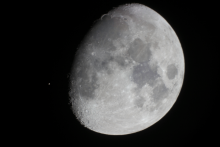Listen to today's episode of StarDate on the web the same day it airs in high-quality streaming audio without any extra ads or announcements. Choose a $8 one-month pass, or listen every day for a year for just $30.
You are here
Moon and Aldebaran
A star is the product of a delicate balance between gravity and radiation. They stay in balance for most of a star’s life. But as the star gets older the balance changes, causing big changes in the star itself.
An example of a star that’s going through that process is in good view tonight. Aldebaran, the bright orange eye of the bull, stands close to the Moon at nightfall.
Gravity squeezes a star tightly, smashing its gas into a compact ball. At the middle of the ball, the gas is heated to millions of degrees — hot enough to ignite nuclear fusion. The fusion produces radiation, which pushes outward, keeping the star in balance.
As the star ages, though, it uses up the hydrogen fuel in its core, producing helium. The helium doesn’t fuse at the same temperature as hydrogen, though. Without nuclear fusion, there’s no radiation to push outward, so gravity squeezes the core even tighter. And as the core shrinks, it gets hotter.
Eventually, it gets hot enough to ignite fusion in the helium. That achieves a new balance — one with a smaller, hotter core. The radiation from the core exerts a stronger outward pressure, causing the surrounding layers of gas to puff outward like a giant balloon.
And that’s what’s happening to Aldebaran. The star has used up its hydrogen, so it’s now ready to burn its helium. So Aldebaran has puffed up to many times the size of the Sun, causing its outer layers to cool — and giving the bull a bright orange eye.



